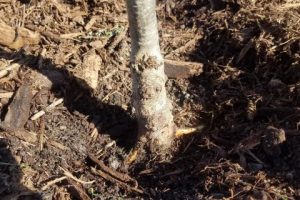Fall is a great time for planting trees
University of Illinois Extension — October 9, 2020
It’s critical that trees are planted at the proper depth with the root flare at the soil surface. This tree’s root flare was identified by finding the first two roots coming out of the trunk. (Photo by Ryan Pankau for University of Illinois Extension)
Most people think of spring as the ideal planting time for trees and shrubs, but fall offers a nice planting window with some added benefits.
“Fall is my favorite time of year to establish woody plants,” said Ryan Pankau, University of Illinois Extension horticulture educator. “With temperatures cooling off, roots need less moisture. And, Illinois typically gets enough fall rains to help ensure adequate soil moisture going into winter.”
All trees and shrubs experience transplant shock, which can last two to three years, sometimes even longer. To overcome transplant shock, trees and shrubs need to expand their root system beyond the planting hole. A mature tree will typically have a root system two to three times wider than the spread of its limbs. When you think about that ratio for a newly planted tree, it takes considerable time to develop an adequate root system.
The most common mistake when planting a tree is digging a hole that is too deep.
“We can really help a tree overcome transplant stress by digging a shallow, wide planting hole,” Pankau said. “A wide hole with well-loosened soil where the edges are roughed up provides a nice space for roots to grow into the native soil.”
Planting holes don’t need to be deep because most of the tree roots are concentrated in the upper 12 to 18 inches of soil. Trees need to be planted at the proper depth, which is typically shallower than expected.
To determine the proper planting depth, start by identifying the root flare, or trunk flare, on a new tree. The flare is the portion of the trunk at the bottom of a tree that begins to flare out, or taper out, as trunk tissue transitions into root tissue. The flare needs to be even with the soil surface.
Trees that are planted too deep struggle to establish and often suffer from a lifetime of other issues. Improper depth is the most common mistake in tree planting because the depth of the tree’s original container, or root ball on balled and burlapped trees, is misleading.
“The root flare of the tree is commonly buried in the pot or down in the root ball on most nursery stock,” Pankau said.
If the root flare on your new tree is not easily identifiable, gently dig down into the container or root ball to search for the first root or roots coming out of the trunk. A young tree will have little trunk taper, making the first roots the best indicator of the root flare.
Mulch provides the finishing touch by adding a protective layer to the soil that retains moisture and prevents roots from freezing. Apply a 2- to 4-inch layer of mulch as wide as your planting hole was dug.
Next spring, the tree will awaken from dormancy and its winter rest with a full canopy of green leaves.
For more information about planting trees, download a printable guide at go.illinois.edu/TreePlantingInfoSheet.



